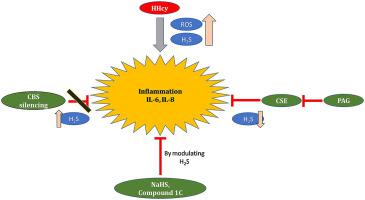Experimental Eye Research ( IF 3.0 ) Pub Date : 2021-09-06 , DOI: 10.1016/j.exer.2021.108759 Ramya Ravi 1 , Anand Kumaraswamy 2 , Preeti Chauhan 3 , Bharathidevi Subramaniam Rajesh 2

|
Plasma homocysteine (Hcy) is an independent risk factor for Age related macular degeneration (AMD) and an inducer of inflammation. Homocysteine catabolism releases hydrogen sulfide (H2S). H2S has controversial effects on inflammation. In this study we have analysed the endogenous and exogenous H2S in modulating inflammation using adult retinal pigment epithelial (ARPE-19) cells as an in vitro model for AMD. ARPE-19 cells were treated with various concentrations of Hcy (15, 30 and 50 μM) for 3 h. Expression of Hcy transulfuration genes (CBS, CSE) by qPCR and western blot. H2S levels were measured using Free Radical Analyzer System (WPI, USA). The inflammatory markers (IL-6 and IL-8) were evaluated using real-time PCR and ELISA. Hcy exposure increased CBS protein expression, hydrogen sulfide levels and pro-inflammatory cytokines, modulating CBS by silencing did not alter H2S levels, but inhibition of CSE with PAG inhibited H2S production and decreased cytokine (IL-6 and IL-8) levels. On the contrary exogenous supply of hydrogen sulfide with NaHS and by compound 1c showed anti-inflammatory effects even in the presence of Hcy. This study shows that exogenous delivery of H2S decreases inflammation in retinal pigment epithelial cells on exposure to Hcy in ARPE-19 cells.
中文翻译:

外源性硫化氢可减轻 ARPE-19 细胞中同型半胱氨酸诱导的炎症
血浆同型半胱氨酸 (Hcy) 是年龄相关性黄斑变性 (AMD) 的独立危险因素和炎症诱导剂。同型半胱氨酸分解代谢释放硫化氢 (H 2 S)。H 2 S 对炎症具有有争议的影响。在这项研究中,我们使用成人视网膜色素上皮 (ARPE-19) 细胞作为AMD 的体外模型分析了内源性和外源性 H 2 S 在调节炎症中的作用。ARPE-19 细胞用不同浓度的 Hcy(15、30 和 50 μM)处理 3 小时。通过 qPCR 和蛋白质印迹表达 Hcy 转硫基因(CBS、CSE)。H 2使用自由基分析仪系统(WPI,美国)测量 S 水平。使用实时 PCR 和 ELISA 评估炎症标志物(IL-6 和 IL-8)。Hcy 暴露增加了 CBS 蛋白表达、硫化氢水平和促炎细胞因子,通过沉默调节 CBS 不会改变 H 2 S 水平,但用 PAG 抑制 CSE 抑制了 H 2 S 产生并减少了细胞因子(IL-6 和 IL-8 ) 水平。相反,外源性硫化氢与 NaHS 和化合物 1c 的供应即使在 Hcy 存在下也显示出抗炎作用。该研究表明,在 ARPE-19 细胞中,H 2 S 的外源性递送减少了视网膜色素上皮细胞在暴露于 Hcy 时的炎症。











































 京公网安备 11010802027423号
京公网安备 11010802027423号